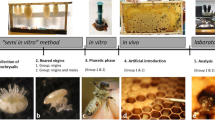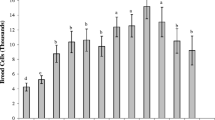Abstract
Varroa destructor is known to be the most serious parasite of Apis mellifera worldwide. In order to reproduce varroa females enter worker or drone brood shortly before the cell is sealed. From March to December 2008, the reproductive rate and offspring mortality (mature and immature stages), focusing on male absence and male mortality of V. destructor, was investigated in naturally infested worker and drone brood of Africanized honey bees (AHB) in Costa Rica. Data were obtained from 388 to 403 single infested worker and drone brood cells, respectively. Mite fertility in worker and drone brood cells was 88.9 and 93.1%, respectively. There was no difference between the groups (X2 = 3.6, P = 0.06). However, one of the most significant differences in mite reproduction was the higher percentage of mites producing viable offspring in drone cells (64.8%) compared to worker cells (37.6%) (X2 = 57.2, P < 0.05). A greater proportion of mites in worker brood cells produced non-viable female offspring. Mite offspring mortality in both worker and drone cells was high in the protonymph stage (mobile and immobile). A significant finding was the high rate of male mortality. The worker and drone brood revealed that 23.9 and 6.9%, respectively, of the adult male offspring was found dead. If the absence (missing) of the male and adult male mortality are taken together the percentage of cells increased to 40.0 and 21.3% in worker and drone cells, respectively (X2 = 28.8, P < 0.05). The absence of the male or male mortality in a considerable number of worker cells naturally infested with varroa is the major factor in our study which reduces the production of viable daughters in AHB colonies in Costa Rica.
Similar content being viewed by others
References
Anderson DL, Trueman JWH (2000) Varroa jacobsoni (Acari:Varroidae) is more than one species. Exp Appl Acarol 24:165–189
Aumeier P, Rosenkranz P, Goncalves L (2000) A comparison of the hygienic response of Africanized and European (Apis mellifera carnica) honey bees to varroa-infested brood in tropical Brazil. Genet Mol Biol 23:787–791
Bailey L, Ball BV (1991) Honey bee pathology, 2nd edn. Academic Press, London, p 193
Boot W (1994) Methyl palmitate does not elicit invasion of honeybee brood cells by varroa mites. Exp Appl Acarol 18:587–592
Boot W, Calis J, Beetsma J (1991) Invasion of varroa mites into honeybee brood cells; when do brood cells attract varroa mites? In: Proceedings experimental and apply entomology, N.E.V. Amsterdam, pp 154–156
Boot W, Calis J, Beetsma J (1992) Differential periods of varroa mite invasion into worker and drone cells of honey bees. Exp Appl Acarol 16:295–301
Boot W, Baalen M, Sabelis M (1995) Why do varroa mites invade worker brood cells of the honey bee despite lower reproductive success? Behav Ecol Sociobiol 36:283–289
Boot W, Tan NQ, Dien PC, Huan LV, Dung NV, Long LT, Beetsma J (1997) Reproductive success of Varroa jacobsoni in brood of its original host, Apis cerana, in comparison to that of its new host, Apis mellifera (Hymenoptera: Apidae). Bull Entomol Res 87:119–126
Boot W, Calis J, Beetsma J, Hai DM, Lan NK, Toan TV, Trung LQ, Minh NH (1999) Natural selection of Varroa jacobsoni explains the different reproductive strategies in colonies of Apis cerana and Apis mellifera. Exp Appl Acarol 23:133–144
Calderón RA, Van Veen JW, Arce HG, Esquivel ME (2003) Presence of deformed wing virus and Kashmir bee virus in Africanized honey bee colonies in Costa Rica infested with Varroa destructor. Bee World 84:112–116
Calderón RA, Zamora LG, Van Veen JW, Quesada MV (2007) A comparison of the reproductive ability of Varroa destructor (Mesostigmata: Varroidae) in worker and drone brood of Africanized honey bees (Apis mellifera). Exp Appl Acarol 43:25–32
Calderone NW, Kuenen LP (2001) Effect of western honey bee, Apis mellifera L. (Hymenoptera: Apidae), colony, cell type and larval sex on host acquisition by female Varroa destructor (Acari: Varroidae). J Econ Entomol 94:1022–1030
Calderone NW, Kuenen LP (2003) Differential tending behavior by nurse bees towards worker and drone larvae of the honey bee, Apis mellifera, during the 60 hours prior to capping. Apidologie 34:543–552
Calderone NW, Lin S (2001) Behavioural responses of Varroa destructor (Acari: Varroidae) to extracts of larvae, cocoons and brood food of worker and drone honey bees, Apis mellifera (Hymentoptera: Apidae). Physiol Entomol 26:241–350
Camazine S (1986) Differential reproduction of the mite, Varroa jacobsoni (Mesostigmata: Varroidae), on Africanized and European honey bees (Hymenoptera: Apidae). Ann Entomol Soc Am 79:801–803
Camazine S (1988) Factors affecting the severity of Varroa jacobsoni infestations on European and Africanized honey bees. In: Needham R, Page R, Delfinado-Baker M, Bowman C (eds) Africanized honey bees and bee mites. Ellis Horwood Series, Chichester, UK, 445–451
Carneiro F, Torres R, Strapazzon R, Ramirez S, Guerra J, Koling D, Moretto G (2007) Changes in the reproductive ability of the mite Varroa destructor (Anderson and Trueman) in Africanized honey bees (Apis mellifera L.) (Hymenoptera: Apidae) colonies in Southern Brazil. Neotrop Entomol 36:949–952
Correa-Marquez MA, Medina L, Martin S, De Jong D (2003) Comparing data on the reproduction of Varroa destructor. Genet Mol Res 2:1–6
De Guzman L, Rinderer TE, Frake A (2007) Growth of Varroa destructor populations in Russian Honey bee (Hymenoptera: Apidae) colonies. Ann Entomol Soc Am 100:187–195
De Jong D (1997) Varroa and other parasites of brood. In: Morse R, Flottum K (eds) Honey bee pest, predators, and diseases, 3rd edn. A.I. Root Company, Ohio, pp 280–327
De Jong D, Goncalves LS, Morse RA (1984) Dependence on climate of the virulence of Varroa jacobsoni. Bee World 65:117–121
De Ruijter A, Calis J (1988) Distribution of Varroa jacobsoni female mites in honey bee worker brood cells of normal and manipulated depth (Acarina: Varroidae). Entomol Gen 14:107–109
Donzé G, Guerin P (1994) Behavioral attributes and parental care of varroa mites parasiting honeybee brood. Behav Ecol Sociobiol 34:305–319
Eguaras E, Marcangeli K, Oppedisano N, Fernandez N (1995) Mortality and reproduction of Varroa jacobsoni in resistant colonies of honey bees (Apis mellifera) in Argentina. Bee Sci 3:174–178
Fries I, Camazine S, Sneyd J (1994) Population dynamics of Varroa jacobsoni: a model and a review. Bee World 75:5–28
Fries I, Huazhen W, Wei S, Chen SJ (1996) Grooming behavior and damaged mites (Varroa jacobsoni) in Apis cerana and Apis mellifera ligustica. Apidologie 27:3–11
Fuchs S (1992) Choice in Varroa jacobsoni Oud. between honey bee drone or worker brood cells for reproduction. Behav Ecol Sociobiol 31:429–435
Fuchs S, Langenbach K (1989) Multiple infestation of Apis mellifera L. brood cells and reproduction in Varroa jacobsoni Oud. Apidologie 20:257–266
Garrido C, Rosenkranz P, Paxton RJ, Goncalves LS (2003) Temporal changes in Varroa destructor fertility and haplotype in Brazil. Apidologie 34:535–541
Goetz B, Koeninger N (1992) Structural features trigger capping of brood cells in honey bees. Apidologie 23:211–216
Goetz B, Koeninger N (1993) The distance between larva and cell opening triggers brood cell invasion by Varroa jacobsoni. Apidologie 24:67–72
Ifantidis MD (1983) Ontogenesis of the mite Varroa jacobsoni in worker and drone honeybee brood cells. J Apic Res 22:200–206
Ifantidis MD (1988) Some aspects of the process of Varroa jacobsoni entrance into honey bee (Apis mellifera) brood cells. Apidologie 19:387–396
Ifantidis MD (1997) Ontogenesis of Varroa jacobsoni Oud. In: Cahiers Options Méditerranéennes, Varroosis in the Mediterranean region. CIHEAM, Zaragoza, ES, pp 13–21
Koeniger N, Koeniger G, Wijayagunasekara NH (1981) Observations on the adaptations of Varroa jacobsoni to its natural host Apis cerana in Sri Lanka. Apidologie 12:37–40
Kuenen LP, Calderone NW (2000) Varroa mite infestations in elevated honey bee brood cells: effects of context and caste. J Insect Behav 13:201–215
Le Conte Y, Arnold G, Trouiller J, Masson C, Chappe B, Ourisson G (1989) Attraction of the parasitic mite varroa to the drone larvae of honey bees by simple aliphatic esters. Science 245:638–639
Martin SJ (1994) Ontogenesis of the mite Varroa jacobsoni Oud. in worker brood of the honeybee Apis mellifera L. under natural conditions. Exp Appl Acarol 18:87–100
Martin SJ (1995) Ontogenesis of the mite Varroa jacobsoni Oud. in drone brood of the honeybee Apis mellifera L. under natural conditions. Exp Appl Acarol 19:199–210
Martin SJ, Kemp D (1997) Average number of reproductive cycles performed by Varroa jacobsoni in honey bees (Apis mellifera) colonies. J Apic Res 36:113–123
Martin SJ, Kryger P (2002) Reproduction of Varroa destructor in South African Honey bees: does cell space influence Varroa male survivorship? Apidologie 33:51–61
Martin SJ, Medina L (2004) Africanized honey bees have unique tolerance to varroa mites. Trends Parasitol 20:112–114
Martin SJ, Holland K, Murray M (1997) Non-reproduction in the honeybee mite Varroa jacobsoni. Exp Appl Acarol 21:539–549
Medina L, Martin SJ (1999) A comparative study of Varroa jacobsoni reproduction in worker cells of honey bees (Apis mellifera) in England and Africanized bees in Yucatan, Mexico. Exp Appl Acarol 23:659–667
Medina L, Martin SJ, Espinosa LM, Ratnieks LF (2002) Reproduction of Varroa destructor in worker brood of Africanized honey bees (Apis mellifera). Exp Appl Acarol 27:79–88
Mondragon L, Martin SJ, Vandame R (2006) Mortality of mite offspring: a major component of Varroa destructor resistance in a population of Africanized bees. Apidologie 37:67–74
Moretto G, Leonidas J (2001) Infestation and distribution of the mite Varroa jacobsoni in Africanized honey bees (Apis mellifera) colonies. Interciencia 26:393–396
Moretto G, Leonidas J (2003) Infestation and distribution of the mite Varroa destructor in colonies of Africanized bees. Braz J Biol 63:83–86
Moretto G, Goncalves L, De Jong D, Bichuette MZ (1991) The effects of climate and bee race on Varroa jacobsoni Oud. infestations in Brazil. Apidologie 22:197–203
Rickli M, Guerin PM, Diehl PA (1992) Palmitic acid released from honeybee worker larvae attracts the parasitic mite Varroa jacobsoni on a servosphere. Naturwissenschaften 79:320–322
Rickli M, Diehl PA, Guerin PM (1994) Cuticle alkanes of honeybee larvae mediate arrestment of bee parasite Varroa jacobsoni. J Chem Ecol 20:2437–2453
Ritter W, De Jong D (1984) Reproduction of Varroa jacobsoni O. in Europe, the middle East and tropical South America. Zeitschrift fur Angewandte Entomologie 98:55–57
Rosenkranz P (1999) Honey bee (Apis mellifera L.) tolerance to Varroa jacobsoni Oud. in South America. Apidologie 30:159–172
Santillan-Galicia M, Otero-Colina G, Romero-Vera C, Cibrian-Tovar J (2002) Varroa destructor (Acari: Varroidae) infestation in queen, worker, and drone brood of Apis mellifera (Hymenoptera: Apidae). Can Entomol 134:381–390
Spivak M (1991) The Africanization process in Costa Rica. In: Spivak M, Fletcher D, Breed M (eds) The “African” honey bee. Westview Press Inc., Colorado, pp 137–155
Trouiller J, Arnold G, Chappe B, Le Conte Y, Mason C (1992) Semiochemical basis of infestation of honey bee brood by Varroa jacobsoni. J Chem Ecol 18:2041–2053
Acknowledgments
We thank M.Sc. Fernando Ramírez and the CINAT beekeeper Guillermo Ramírez for the assistance with the fieldwork and the beekeeper Narcizo Campos for his cooperation and loan of the AHB colonies.
Author information
Authors and Affiliations
Corresponding author
Rights and permissions
About this article
Cite this article
Calderón, R.A., Ureña, S. & van Veen, J.W. Reproduction of Varroa destructor and offspring mortality in worker and drone brood cells of Africanized honey bees. Exp Appl Acarol 56, 297–307 (2012). https://doi.org/10.1007/s10493-012-9518-0
Received:
Accepted:
Published:
Issue Date:
DOI: https://doi.org/10.1007/s10493-012-9518-0




